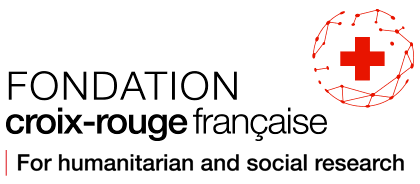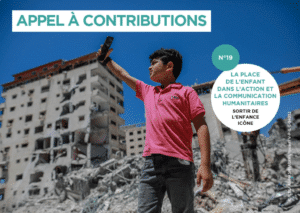The place of the child in humanitarian action and communication: moving away from the cliché of the childhood icon
A Focus codirected by Valérie Gorin, teaching fellow and researcher at the Centre of Humanitarian Studies, Geneva (University of Geneva and Graduate Institute of International and Development Studies), and Boris Martin, Editor-in-Chief of Humanitarian Alternatives
On 23 February 1923, the first Declaration of the Rights of the Child was adopted in Geneva. Under the aegis of the International Save the Children Union, it established a global movement in the wake of the First World War, ranging from the large-scale opening of canteens to the expansion of the market for powdered milk by way of transnational action to limit child labour. Almost a century later, the image of the child dominates the communications media issued by humanitarian organisations, which rely heavily on the figure of the innocent, hungry or wounded child to raise funds. In doing so, they often promote a reductive vision of childhood, part idealised, part martyred – the figure of a child as icon.
Although this trope has long been criticised, it shows no signs of going away. Indeed, the figure of the child in danger has given rise to notorious abuse, from the scandal of stolen children in Chad by members of L’Arche de Zoé in 2007 to the trade in fake orphanages in Nepal that emerged following the earthquake of 2015, encouraged by the growing and lucrative business of “voluntourism”.
The use of the iconography of childhood in humanitarian work has already been the subject of numerous research projects over the past twenty years, but with the recurring problems it raises today in the face of multiple humanitarian issues, it merits further examination. The exploitation of childhood-martyrdom as a front for compassionate geopolitics has indeed increased in recent years, thanks to numerous cases of social media hype. The photograph of Alan Kurdi, the Kurdish child found dead on a Turkish beach in September 2015 (whose photograph was shared on Twitter by the emergency director of Human Rights Watch), remains the most striking example. Since then, many responses have been issued by other parties with different motivations. We remember, for example, the controversial cases of Omran Daqneesh, a young Syrian boy whose bloodied face in an ambulance was broadcast by local photographers in August 2016, or of the photograph featuring the Turkish president Erdogan with Bana Al-Abed, a 7-year-old Syrian girl who told the story of the war from Aleppo before being evacuated by Turkey in December 2016. Two media cases in which the image of children at risk – reposted ad nauseam on social networks – has been exploited for the benefit of a political regime directly involved in the Syrian armed conflict.
The use of the image of childhood has led humanitarian organisations to develop or review codes of ethical conduct to take into account the over-representation of children in humanitarian appeals, including the issue of consent and accountability. In addition, multiple sectors of international aid consider the identity, autonomy and participation of young beneficiaries. Many projects are flourishing in the areas of natural risk reduction and post-conflict demobilisation and disarmament, which include an active approach with regards to children, from needs assessments to the setting up of specific activities in spaces adapted to young people.
Yet is this wholesome development commensurate with the social, legislative, and emotional changes taking place in other social spheres, such as education, care or the family environment, which bear witness to new sensibilities and representations of the child? Implicitly, this global transformation questions a phenomenon that is still all too frequent in the humanitarian field: an over-exaggeration of children perceived as figures of otherness and reduced to a victimised and protective vision inherited from the nineteenth century, at the expense of a more realistic representation of children as thinking and active beings, including of course all due consideration for the constraints inherent in their condition. This issue was given serious consideration in the 1989 United Nations Convention on the Rights of the Child, which recognised autonomy and the right to expression in childhood, but which has struggled to impose itself in light of new ways of regarding childhood as suffering or childhood as fighting. Consider the issue of child soldiers, whose image is still largely reduced to one of boys fighting and girls turned into sex slaves, whereas the reality is more complex, as well as the reintegration of children into the communities involved. The same goes for NGO action in favour of the deradicalisation of child soldiers of the Islamic State or the children of jihadists, detained in Iraq or Syria, which remains hesitant and seldom discussed. We should also mention the aid programmes on gender and sexual violence, which have benefited from wide exposure in recent years, even though they make women victims of abuse a priority, to the detriment of children. Humanitarian organisations are effectively more reluctant to directly mention the sexual exploitation of children, or the abuses committed by some of their staff, even as denunciations of paedophilia are multiplying in Catholic circles, as evidenced by the latest report of the Sauvé Commission in France.
This new Focus aims to take stock of what has become of the figure of childhood in the humanitarian field today, proposing to move beyond the question of the child as an image in an effort to address the issues mentioned above: to what extent does the elevation of the child to the status of icon not serve the humanitarian project? How can we transcend the traditional attributes of children in danger (innocence, disempowerment) to explore and empower a participatory and resilient form of childhood? How is it possible to overcome the taboos linked to the classical vision of idealised childhood?
Translated from the French by Juliet Powys
Submit a proposal for an article
If you are an actor, researcher or observer in the international humanitarian community and wish to submit an article proposal on this subject, please send a summary and a draft plan (two pages maximum) to the following email address by 20 December 2021: contact@alternatives-humanitaires.org. You will receive a reply by 24 December 2021 at the latest.
The final deadline for submitting the article is 31 January 2022. The article should be around 15,000 characters including spaces (around 2,400 words). Six or seven articles will be selected for this Focus.
Subject:
The Humanitarian Alternatives Review
Guidelines:
• Characters: 15,000 including spaces (approx. 2,400 words)
• Abstract submission: 20 December 2021
• Article submission: 31 January 2022


